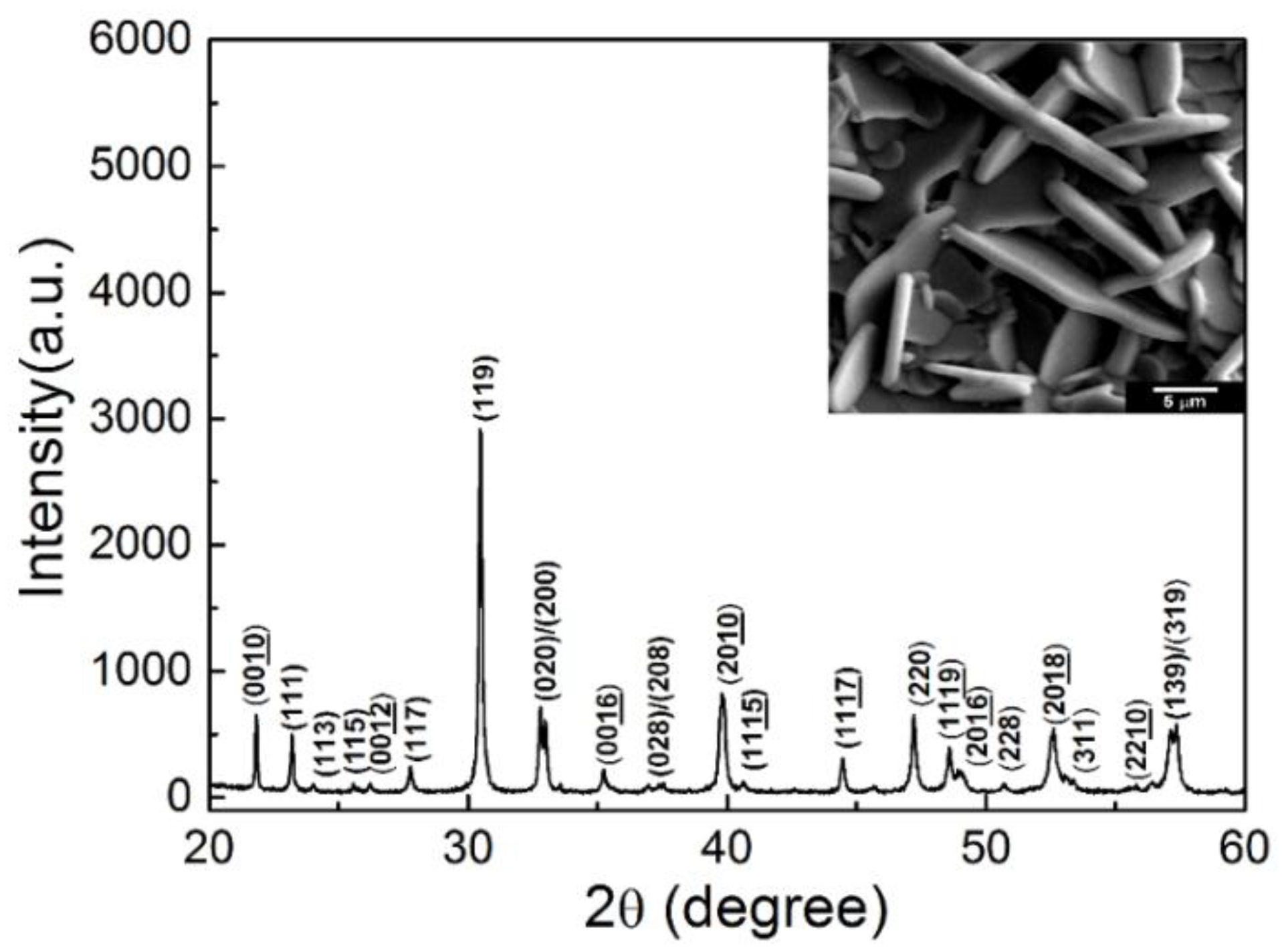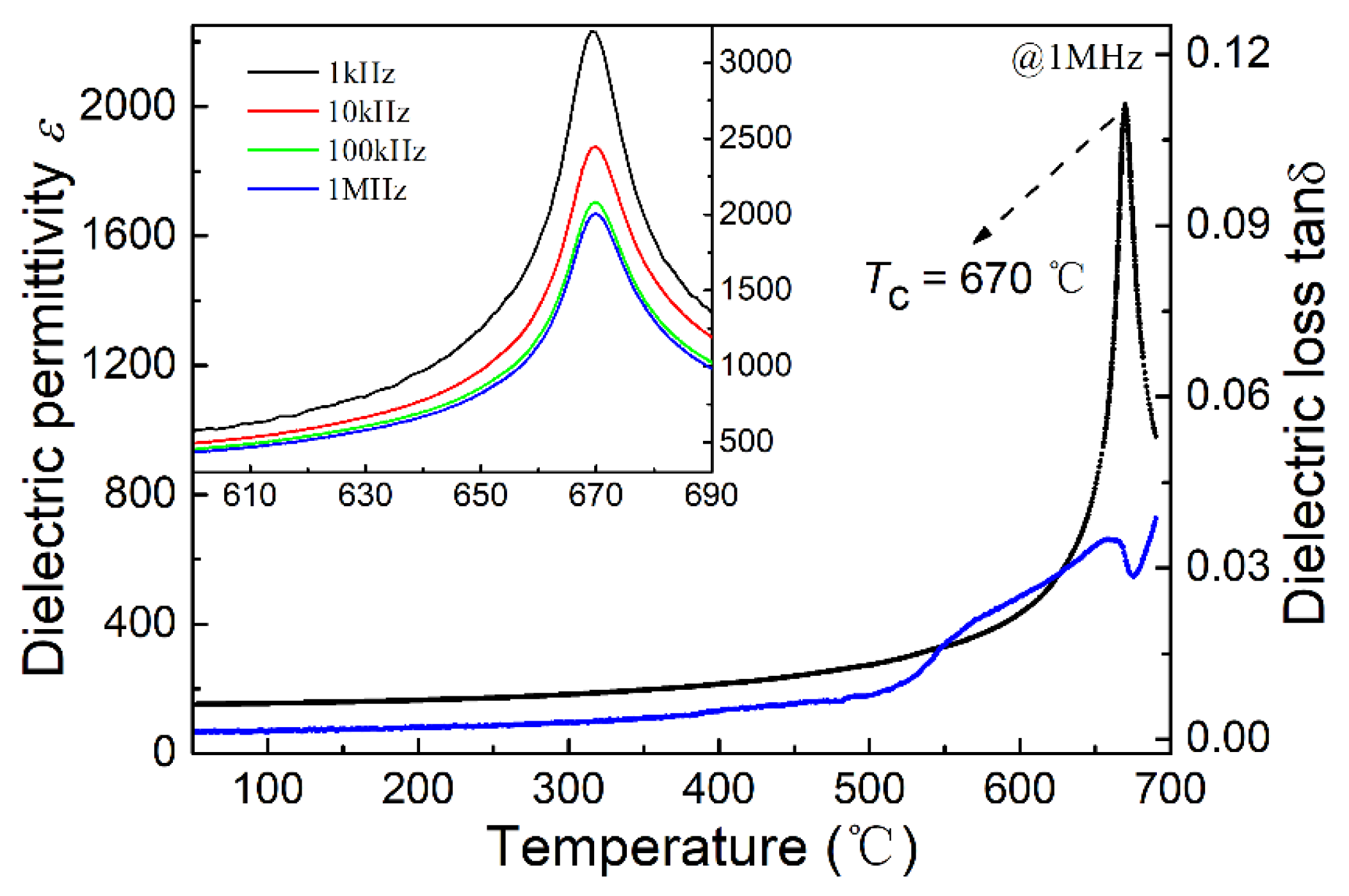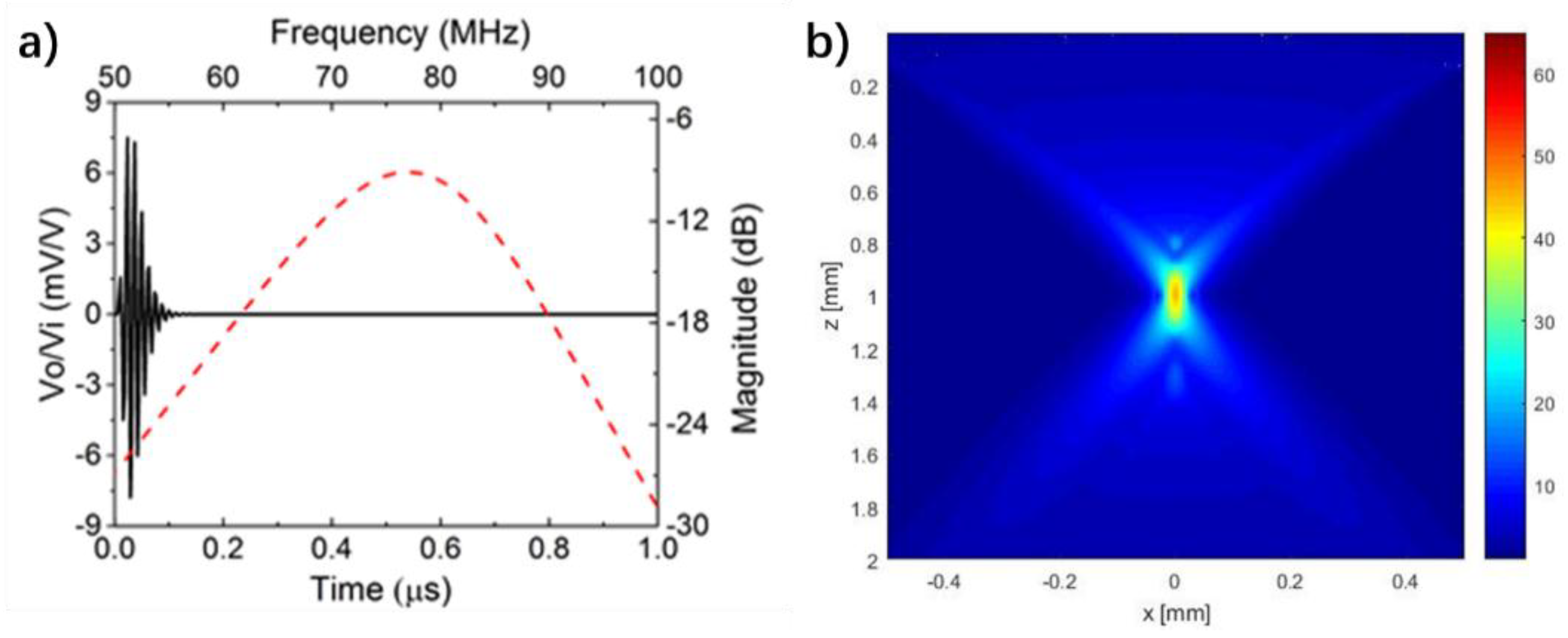High Frequency Needle Ultrasonic Transducers Based on Lead-Free Co Doped Na0.5Bi4.5Ti4O15 Piezo-Ceramics
Abstract
:1. Introduction
2. Fabrication and Characterization of Co-Doped Na0.5Bi4.5Ti4O15 Ceramics
2.1. Fabrication
2.2. Characterization
3. Design, Fabrication, and Characterization of Tightly Focused Needle Ultrasonic Transducer
3.1. Transducer Design and Fabrication
3.2. Transducer Characterization
4. Conclusions
Author Contributions
Acknowledgments
Conflicts of Interest
References
- Pavlin, C.J.; Harasiewicz, K.; Sherar, M.D.; Foster, F.S. Clinical use of ultrasound biomicroscopy. Ophthalmology 1991, 98, 287–295. [Google Scholar] [CrossRef]
- Foster, F.S.; Lockwood, G.R.; Ryan, L.K.; Harasiewicz, K.A.; Berube, L.; Rauth, A.M. Principles and applications of ultrasound backscatter microscopy. IEEE Trans. Ultrason. Ferroelectr. Freq. Control 1993, 40, 608–617. [Google Scholar] [CrossRef] [PubMed]
- Khairy, H.A.; Atta, H.R.; Green, F.D.; Van der Hoek, J.; Azuara-Blanco, A. Ultrasound biomicroscopy in deep sclerectomy. Eye 2005, 19, 555. [Google Scholar] [CrossRef] [PubMed]
- Fei, C.L.; Chiu, C.T.; Chen, X.Y.; Chen, Z.Y.; Ma, J.G.; Zhu, B.P.; Shung, K.K. and Zhou, Q.F. Ultrahigh frequency (100–300MHz) ultrasonic transducers for optical resolution medical imagining. Sci. Rep. 2016, 6, 20360. [Google Scholar] [CrossRef] [PubMed]
- Zhu, B.; Fei, C.; Wang, C.; Zhu, Y.; Yang, X.; Zheng, H.; Zhou, Q.; Shung, K.K. Self-Focused AlScN Film Ultrasound Transducer for Individual Cell Manipulation. ACS Sens. 2017, 2, 172–177. [Google Scholar] [CrossRef] [PubMed]
- Fei, C.; Hsu, H.S.; Vafanejad, A.; Li, Y.; Lin, P.; Li, D.; Yang, Y.; Kim, E.; Shung, K.K.; Zhou, Q. Ultrahigh frequency ZnO silicon lens ultrasonic transducer for cell-size microparticle manipulation. J. Alloys Compd. 2017, 729, 556–562. [Google Scholar] [CrossRef]
- Zhou, Q.F.; Lau, S.; Wu, D.W.; Shung, K.K. Piezoelectric films for high frequency ultrasonic transducers in biomedical applications. Prog. Mat.Sci. 2011, 56, 139–174. [Google Scholar] [CrossRef] [PubMed] [Green Version]
- Zhu, F.; Qiu, J.; Ji, H.; Zhu, K.; Wen, K. Comparative investigations on dielectric, piezoelectric properties and humidity resistance of PZT-SKN and PZT-SNN ceramics. J. Mater. Sci. Mater. Electron. 2015, 26, 2897–2904. [Google Scholar] [CrossRef]
- Zhou, Q.; Lam, K.H.; Zheng, H.; Qiu, W.; Shung, K.K. Piezoelectric single crystal ultrasonic transducers for biomedical applications. Prog. Mater. Sci. 2014, 66, 87–111. [Google Scholar] [CrossRef] [PubMed] [Green Version]
- Saito, Y.; Takao, H.; Tani, T.; Nonoyama, T.; Takatori, K.; Homma, T.; Nagaya, T.; Nakamura, M. Lead-free piezoceramics. Nature 2004, 432, 84. [Google Scholar] [CrossRef] [PubMed]
- Ringgaard, E.; Wurlitzer, T. Lead-free piezoceramics based on alkali niobates. J. Eur. Ceram. Soc. 2005, 25, 2701–2706. [Google Scholar] [CrossRef]
- Maeder, M.D.; Damjanovic, D.; Setter, N. Lead free piezoelectric materials. J. Electroceram. 2004, 13, 385–392. [Google Scholar] [CrossRef]
- Gao, D.; Kwok, K.W.; Lin, D. Microstructure, piezoelectric and ferroelectric properties of Mn-added Na0.5Bi4.5Ti4O15 ceramics. Curr. Appl. Phys. 2011, 11, S124–S127. [Google Scholar] [CrossRef]
- Peng, Z.; Chen, Q.; Wu, J.; Liu, D.; Xiao, D.; Zhu, J. Dielectric properties and impedance analysis in Aurivillius-type (Na0.25K0.25Bi0.5) 1 − x (LiCe) x/2 [] x/2Bi4Ti4O15 ceramics. J. Alloys Compd. 2012, 541, 310–316. [Google Scholar]
- Zhao, T.L.; Guo, Z.L.; Wang, C.M. The Effects of Na/K Ratio on the Electrical Properties of Sodium-Potassium Bismuth Titanate Na0.5Bi4.5Ti4O15-K0.5Bi4.5Ti4O15. J. Am. Ceram. Soc. 2012, 95, 1062–1067. [Google Scholar] [CrossRef]
- Zhao, L.; Xu, J.X.; Yin, N.; Wang, H.C.; Zhang, C.J.; Wang, J.F. Microstructure, dielectric, and piezoelectric properties of Ce-modified Na0.5Bi4.5Ti4O15 high temperature piezoceramics. Phys. Status Solidi (RRL)-Rapid Res. Lett. 2008, 2, 111–113. [Google Scholar] [CrossRef]
- Wang, C.M.; Wang, J.F.; Zhang, S.; Shrout, T.R. Electromechanical properties of a-site (LiCe)-modified sodium bismuth titanate (Na0.5Bi4.5Ti4O15) piezoelectric ceramics at elevated temperature. J. Appl. Phys. 2009, 105, 094110. [Google Scholar] [CrossRef]
- Chen, H.; Shen, B.; Xu, J.; Zhai, J. Textured Ca0.85(Li, Ce)0.15Bi4Ti4O15 ceramics for high temperature piezoelectric applications. Mater. Res. Bull. 2012, 47, 2530–2534. [Google Scholar] [CrossRef]
- IEEE Standard on Piezoelectricity (ANSI/IEEE Standard No. 176, 1987).






| Tc (°C) | ε33T | Tan δ (%) | d33 (pC/N) | kp (%) | kt (%) | Np (Hz·m) | Nt (Hz·m) |
|---|---|---|---|---|---|---|---|
| 670 | 148 | 0.26 | 32 | 5.2 | 35.3 | 2320 | 2280 |
| Property | NBT-Co |
|---|---|
| Longitudinal velocity υ | 4600 m/s |
| Density ρ | 6500 kg/m3 |
| Acoustic impedance Z | 29.9 MRayl |
| Clamped relative dielectric constant εr | 20 |
| Dielectric loss tan δ | 0.0026 |
| Thickness electromechanical coupling kt | 0.353 |
| Piezoelectric coefficient d33 | 32 pC/N |
| Property | NBT-Co Transducer |
|---|---|
| Center frequency (MHz) | 70.4 |
| Peak to peak Voltage (mV) @ 0 dB gain | 123 |
| −6dB Bandwidth | 52.7% |
| Focus depth (mm) | 1.02 |
| ƒ-number | 1.03 |
© 2018 by the authors. Licensee MDPI, Basel, Switzerland. This article is an open access article distributed under the terms and conditions of the Creative Commons Attribution (CC BY) license (http://creativecommons.org/licenses/by/4.0/).
Share and Cite
Fei, C.; Zhao, T.; Wang, D.; Quan, Y.; Lin, P.; Li, D.; Yang, Y.; Cheng, J.; Wang, C.; Wang, C.; et al. High Frequency Needle Ultrasonic Transducers Based on Lead-Free Co Doped Na0.5Bi4.5Ti4O15 Piezo-Ceramics. Micromachines 2018, 9, 291. https://doi.org/10.3390/mi9060291
Fei C, Zhao T, Wang D, Quan Y, Lin P, Li D, Yang Y, Cheng J, Wang C, Wang C, et al. High Frequency Needle Ultrasonic Transducers Based on Lead-Free Co Doped Na0.5Bi4.5Ti4O15 Piezo-Ceramics. Micromachines. 2018; 9(6):291. https://doi.org/10.3390/mi9060291
Chicago/Turabian StyleFei, Chunlong, Tianlong Zhao, Danfeng Wang, Yi Quan, Pengfei Lin, Di Li, Yintang Yang, Jianzheng Cheng, Chunlei Wang, Chunming Wang, and et al. 2018. "High Frequency Needle Ultrasonic Transducers Based on Lead-Free Co Doped Na0.5Bi4.5Ti4O15 Piezo-Ceramics" Micromachines 9, no. 6: 291. https://doi.org/10.3390/mi9060291





